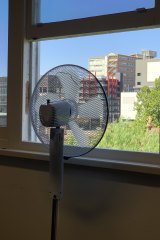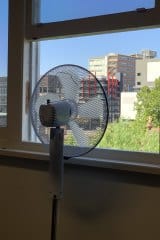Burnet Institute epidemiologist Professor Mike Toole said the 12 coronavirus cases were a mini super-spreading event, but one that would not have made sense nine months ago when it was thought that coronavirus was mostly spread by large droplets.
He said it seemed the virus had spread via finer particles known as aerosols, meaning social distancing might not always be adequate protection from the disease, particularly in poorly ventilated rooms where people were speaking loudly.
“The traditional 1.5 metres apart isn’t enough in that setting, so masks become absolutely critical,” he said.
Air quality experts say the case highlights the need for restaurants and other venues to improve their ventilation, an issue they say has been overlooked in comparison to social distancing and hand hygiene.
They say there are a number of simple measures that can help such as opening windows, while warning air-conditioners or fans used incorrectly may spread the virus.
It appears the Smile Buffalo Thai does not have any opening windows to the street, just a single door providing entry off Beach Road. There is no suggestion the venue did anything wrong, rather the Health Department confirmed that they had been respecting density rules, which require venues with more than 25 patrons to limit customers to one person for every two square metres.
The restaurant operators couldn’t be contacted by The Age this week.
Genomic testing has linked the Black Rock cluster to the northern beaches outbreak in NSW, but work is still under way to establish exactly how the virus made its way to Melbourne.
A Victorian Health Department spokeswoman said there had been site assessments by infection-control and occupational health experts and analysis of epidemiological data to try to identify potential missing links.
Loading
“We have formed a dedicated acquisition investigation team made up of epidemiological, contact tracing, occupational physician, infection-prevention control and public health staff to continue this investigation,” she said.
“A number of factors are likely to have contributed to the transmission in the restaurant including the infectivity of the case or cases who were present, where they were seated and airflow in the restaurant — all of which are being investigated.”
The last case linked to the Black Rock cluster was reported on Tuesday and authorities are now hopeful it has been contained, after growing to 27 cases when close contacts of those at the restaurant also become infected.
Dr Robyn Schofield, director of the environmental science hub at the University of Melbourne, said businesses needed to be better informed about how they could improve air quality.
She said while aerosols would always be in their highest density closest to a person, they could remain in the air for a long time when there was low relative humidity.
“A five-micron particle will be airborne for 25 minutes and travel up to 400 metres indoors, so that’s a lot further than any of your social distancing.”
Loading
Dr Schofield said venue operators should check for areas where there was no fresh air, keep kitchen exhausts running and use a carbon-dioxide sensor to check if the rate of C02 was above 600, a rate where ventilation could be required. She said fresh air usually had a C02 level of about 415 parts per million. “You can tell a space is poorly ventilated if it has high C02,” she said.
Outdoor dining has been heavily promoted in Victoria to reduce coronavirus spread. Cafes and pubs have been allowed to set up tables and chairs on footpaths, parks and other public land without the need for a planning permit.

Professor Jason Monty says air flow can be improved by setting up a fan at a window.
Victorian businesses operators are also advised to avoid interactions in closed spaces and improve ventilation by opening windows and doors as part of their COVID-safe plans.
Professor Jason Monty, the head of mechanical engineering at the University of Melbourne, said some small restaurants didn’t have any ventilation other than doorways or a split-system air-conditioner, which blowed air in one direction around the room.
He said opening windows might be only of limited benefit in these circumstances because there was nothing pushing the air out of the shop, so he recommended setting up a fan at the window to push the air out, or an air purifier.
“We need to put a bit more effort into encouraging people to try to clean air in their restaurants,” he said.
Get our Coronavirus Update newsletter
Stay across the news you need to know related to the pandemic. Sent Monday and Thursday. Sign up here.
Aisha Dow reports on health for The Age and is a former city reporter.
Most Viewed in National
Loading
The post Airflow and seating likely factors in Thai restaurant cluster – The Age first appeared on Atablefortwo.com.au.
This content was originally published here.



